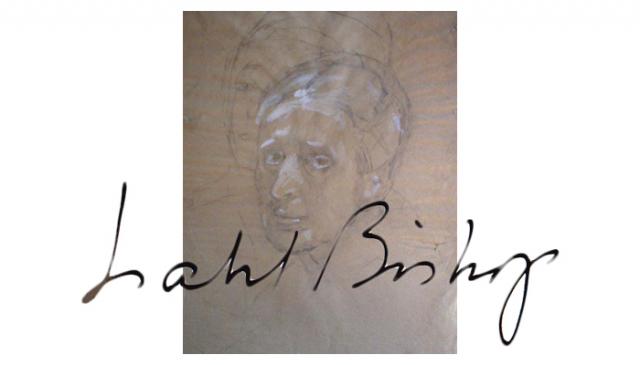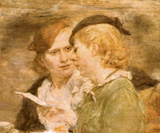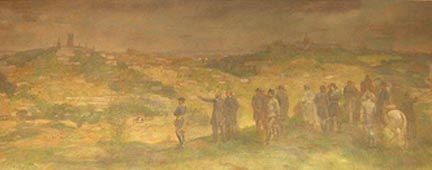Isabel Bishop (1902-1988) was a painter and printmaker who depicted life in Union Square, New York, from the 1930s through the 1970s. She was best known for painting common American women performing their daily activities.
Artist Isabel Bishop came from an intellectual household. Her parents were both scholars and educators. Her father, Dr. J. Remsen Bishop, was a Latin and Greek scholar. Her mother, a Suffragist and feminist, wanted to be a writer, but was never published. She learned Italian in order to translate Dante's Inferno into English. The couple had founded a prep school in Princeton, New Jersey, but abandoned their project when family life and work combined became overwhelming. The family moved to Cincinnati where Dr. Bishop taught and eventually became principal at the Walnut Hills School.
Thirteen years after they had two sets of twins, they had Isabel on March 3, 1902, in Cincinnati. The family was often struggling financially, and her father's cousin, James Bishop Ford, was their wealthy benefactor. The family moved from Cincinnati to Detroit, where her father was principal of Eastern High School and taught Greek and Latin. He also wrote textbooks in these fields. They lived on the edge of a working class area, and Isabel was not allowed to play with the neighborhood's children. It was in Detroit in 1917, where Bishop studied at the Wicker School, that Bishop developed her interest in art, however. During Saturday morning art classes, she learned to draw from life.
New York and the Art Students League
In 1918, a 16-year-old Bishop moved to New York City, with the financial help of Ford, to study illustration and design at the New York School of Applied Design for Women. She lived at the Misses Wilde's boarding house for young women on the Upper East Side. She was impressed by modernism, a trend following from the 1913 Armory Show.
"I remember us art students in our smocks, walking in the Armistice Day parade. Then I learned about modern art and put commercial art behind me. I enrolled at the Art Students League and moved to the Village with two other girls," Bishop told biographer Helen Yglesias.
It was then that she decided to abandon illustration and enter the world of fine art. From 1922 to 1924, she attended classes at the Art Students League of New York. First, she studied with modernist Max Weber, then with realist painter Kenneth Hayes Miller. She studied the techniques of the European Masters, but was also influenced by a group of New York social realists led by painter Robert Henri and known as the Ash Can School for their depictions of back yards, alleys, and trash cans.
The Fourteenth Street School
She became friends with Reginald Marsh who also admired Miller. Marsh, also a student at the League, was a Yale grad, whose first job in New York was reviewing burlesque shows for the Daily News. She was influenced by Marsh's drawings and prints of working-class subjects. She also developed a friendship with Guy Pene du Bois, another teacher at the League who painted satiric pictures of the New York café scene.
Bishop left the League, she set up her first studio on Union Square. In 1926, she lived and worked at 9 West Fourteenth Street in a loft. It was here that she became part of the group known as "The Fourteenth Street School," along with Reginald Marsh and the Soyer brothers. She later returned to the Art Students League to study mural painting with Miller. That same year, at age 24, she tried to commit suicide on three different occasions because of a love affair that ended badly. She jumped into the Hudson River in the middle of the night. She commented later that her body wouldn't die, that it started swimming.
In 1931, Ford funded a trip to Europe for Bishop. She traveled with Kenneth Hayes Miller, Reginald Marsh, and Edward Laning. She toured museums and studied the techniques of the Great Masters. When she returned to Union Square, she started her first drawings of the Square and its people. In 1932, she painted "Virgil and Dante in Union Square," now housed at the Delaware Art Museum in Wilmington. A favorite of Bishop's, for many years it hung in her house at Riverdale.
Marriage and a New Studio
Donning a white smock and tennis shoes at her studio, Bishop was a very private person who worked slowly. She never needed to depend on her work to earn a living, however. On August 9, 1934, at the age of 32, she married Harold G. Wolff, a leading neurologist. The couple had a son, Remsen, born on April 6, 1940. Their happy 28-year marriage ended with the death of Dr. Wolff on February 21, 1962.
The doctor had a keen interest in art and wholeheartedly supported her work. As Bishop once said, "He found no contradiction between science and art. As far as truth and reality were concerned, there was no either/or about it."
Also in 1934, Bishop took a studio on the top floor of an office building at 857 Broadway on Union Square. She kept that same studio, taking the subway from 242nd St. near her home in Riverdale, the Bronx, to Union Square until she had to give it up in 1984 after the onset of illnes.
Painted the Working Girls
The first painting to bring Bishop national recognition was her "Two Girls," which was purchased in 1936 by the Metropolitan Museum of Art in New York. The two girls were a waitress, Rose Riggens Hirschberg, and her friend Anna Abbott Sweeters. Rose was quoted in the New York World-Telegram, "I can't get over it - this picture causing all the commotion. I never thought much about it. I thought about how Miss Bishop used to come into Childs in the morning and have three cups of black coffee and toast for breakfast."
Bishop became most famous for her portraits of the working girls of New York. Suspended in time, female friends were pictured in parks, soda fountains, and snack bars from the 1930s through the 1960s. She described these pictures as an effort "to catch the fleeting moment without freezing its flight." Bishop is also known for her introspective nudes. Her figures are almost always depicted in motion, doing some activity, undressing, clipping toenails, bending, or reaching.
In March 1936 she showed her work at the Art Students League where she was employed as an instructor that year. In 1938 she painted a mural for the New Lexington, Ohio, Post Office. The work, an 11-foot long oil on canvas, called Great Men Come From The Hills, was commissioned by the Section of Fine Arts of the U.S. Treasury Department.
"Great Men Came from the Hills" Post Office - Lexington, Ohio - Isabel Bishop. 1938
In January 1939, an art critic at Time wrote, in an article titled, "Bishop's Progress": "In the last few years Isabel Bishop's paintings have mildly haunted many a visitor to bit exhibitions. Her style, formed by thorough study at Manhattan's Art Students League and exceptional resistance to its influence, is noted for: (1) sensitive modeling of form, and (2) a submarine pearliness and density of atmosphere. The thing she feels about (the working girls) and tries to communicate in her painting, she says is their 'mobility in life,' the very fact that they do not belong irrevocably to a certain class, that anything may happen to them.
Years of Recognition and Reality
During the 1940s, she continued to develop a name for herself in the art world. In 1940, she exhibited her work at the New York World's Fair, won first prize at the American Society of Graphic Artists show, and was elected an Associate of the National Academy of Design in New York. She also held a solo exhibition at the Herbert Institute, Atlanta. The following year, she was elected an Academician of the National Academy of Design in New York.
In 1942 she was awarded the Adolph and Clara Obrig Prize of the National Academy of Design, New York, for oil, "Nude by Stream." She also developed a relationship with the National Institute of Arts and Letters in New York: In 1943, she was presented the Arts and Letters Award, the following year, she was elected a member of the Institute, and in 1946, she became the first woman to be elected an officer of the Institute when she was elected vice president. She continued to hone new skills as well, studying engraving at the New School for Social Research in New York in 1945.
In the 1950s, she became one of the founding members of a new journal called Reality. Raphael Soyer started the journal for realist artists. She told interviewer Barbaralee Diamonstein in Inside New York's Art World in 1979, "In four years we issued four copies - four copies in four years - and these weren't sold, we sent them to universities and libraries and so on. Art magazines became absolutely furious. They wrote long diatribes … after four issues there was no use going on - we had all said what we had to say. But it is remembered now as a sort of collector's item."
During the mid-1950s, she continued to collect honors for her work. In 1954, she was awarded an honorary Doctor of Fine Arts Degree from Moore Institute of Art, Science and Industry in Philadelphia. She was awarded the first Benjamin Altman Prize of the National Academy of Design in New York for "Girls in the Subway Station" in 1955. During the summers of 1956, 1957, and 1958, Bishop taught at Skowhegan School of Painting and Sculpture in Skowhegan, Maine. She resumed teaching there in 1963.
Pride and Prejudice
The Whitney Museum held a retrospective of her work in 1975. In 1976, E.P. Dutton & Co. published a new version of Jane Austen's Pride and Prejudice with Bishop's illustrations, as well as an afterword written by the artist. Bishop's work for the book had been commissioned in the mid-1940s, but for various reasons, the publication had been delayed some thirty years.
The late seventies and the eighties saw Bishop receiving more recognition. In 1979, President Jimmy Carter presented her with an Outstanding Achievement in the Arts Award. In 1982, she received the Skowhegan Governors Award, and in 1987, she was awarded the Gold Medal for Printing of the American Academy and Institute of Arts and Letters.
Isabel Bishop died of Parkinson's disease at her home in Riverdale, the Bronx, in February 1988 at 85. Funeral services were held at Christ Church in Riverdale. Yglesias met with her only weeks before she died. She commented, "Always meticulously groomed, even during the last days of her life, her hair smoothly done, her skin surprisingly luminous and unlined, Isabel Bishop was the epitome of the perfect lady, the perfect hostess."
In 1975, biographer Karl Lunde appraised Bishop's work: "She speaks to a sophisticated audience, to viewers aware that the woman reading a letter in a Vermeer or the peaches in a Chardin are only superficially the subjects of those paintings. The real subjects are problems of art taking one beyond mere appearance. The artist, with each stroke of the brush, transforms, reforms, rearranges, selects, magnifies, rejects, organizes and reorganizes. Relationships are Isabel Bishop's theme; the human figure, the means."
Her signature changed many times over her career, ranging from the use of various pseudonyms to initials; some early pieces are signed I.B, or I. Bishop in both block and script.
| PUBLIC COLLECTIONS The works of Isabel Bishop are present in an impressive list of public collections | ||||||||||||||||||||||||||||||||||||||||||||||||||||||||||||||||||||||||||||||||||||||||||||||||||||||||||||||||||||||||||||||||||||||||||||||||||||||||||||||||||||||||||||||||||||||||||||||||||||||||||||||||||||||||||||||||||||||||||||||||||||||||||||||||
| Addison Gallery of American Art, Phillips Academy, Andover, Massachusetts | ||||||||||||||||||||||||||||||||||||||||||||||||||||||||||||||||||||||||||||||||||||||||||||||||||||||||||||||||||||||||||||||||||||||||||||||||||||||||||||||||||||||||||||||||||||||||||||||||||||||||||||||||||||||||||||||||||||||||||||||||||||||||||||||||
| American Academy of Arts and Letters, New York | ||||||||||||||||||||||||||||||||||||||||||||||||||||||||||||||||||||||||||||||||||||||||||||||||||||||||||||||||||||||||||||||||||||||||||||||||||||||||||||||||||||||||||||||||||||||||||||||||||||||||||||||||||||||||||||||||||||||||||||||||||||||||||||||||
| Atlanta University, Atlanta, Georgia | ||||||||||||||||||||||||||||||||||||||||||||||||||||||||||||||||||||||||||||||||||||||||||||||||||||||||||||||||||||||||||||||||||||||||||||||||||||||||||||||||||||||||||||||||||||||||||||||||||||||||||||||||||||||||||||||||||||||||||||||||||||||||||||||||
Baltimore Museum of Art, Baltimore, Maryland | ||||||||||||||||||||||||||||||||||||||||||||||||||||||||||||||||||||||||||||||||||||||||||||||||||||||||||||||||||||||||||||||||||||||||||||||||||||||||||||||||||||||||||||||||||||||||||||||||||||||||||||||||||||||||||||||||||||||||||||||||||||||||||||||||
Brooklyn Museum, Brooklyn, New York | ||||||||||||||||||||||||||||||||||||||||||||||||||||||||||||||||||||||||||||||||||||||||||||||||||||||||||||||||||||||||||||||||||||||||||||||||||||||||||||||||||||||||||||||||||||||||||||||||||||||||||||||||||||||||||||||||||||||||||||||||||||||||||||||||
| Brooks Memorial Art Gallery, Memphis, Tennessee | ||||||||||||||||||||||||||||||||||||||||||||||||||||||||||||||||||||||||||||||||||||||||||||||||||||||||||||||||||||||||||||||||||||||||||||||||||||||||||||||||||||||||||||||||||||||||||||||||||||||||||||||||||||||||||||||||||||||||||||||||||||||||||||||||
| Butler Institute of American Art, Youngstown, Ohio | ||||||||||||||||||||||||||||||||||||||||||||||||||||||||||||||||||||||||||||||||||||||||||||||||||||||||||||||||||||||||||||||||||||||||||||||||||||||||||||||||||||||||||||||||||||||||||||||||||||||||||||||||||||||||||||||||||||||||||||||||||||||||||||||||
| California Palace of the Legion of Honor, San Francisco | ||||||||||||||||||||||||||||||||||||||||||||||||||||||||||||||||||||||||||||||||||||||||||||||||||||||||||||||||||||||||||||||||||||||||||||||||||||||||||||||||||||||||||||||||||||||||||||||||||||||||||||||||||||||||||||||||||||||||||||||||||||||||||||||||
| Clearwater Gulf Coast Art Center, Clearwater, Florida | ||||||||||||||||||||||||||||||||||||||||||||||||||||||||||||||||||||||||||||||||||||||||||||||||||||||||||||||||||||||||||||||||||||||||||||||||||||||||||||||||||||||||||||||||||||||||||||||||||||||||||||||||||||||||||||||||||||||||||||||||||||||||||||||||
| Colby College Art Museum, Waterville, Maine | ||||||||||||||||||||||||||||||||||||||||||||||||||||||||||||||||||||||||||||||||||||||||||||||||||||||||||||||||||||||||||||||||||||||||||||||||||||||||||||||||||||||||||||||||||||||||||||||||||||||||||||||||||||||||||||||||||||||||||||||||||||||||||||||||
| Colorado Springs Fine Arts Center and Taylor Museum, Colorado Springs, Colorado | ||||||||||||||||||||||||||||||||||||||||||||||||||||||||||||||||||||||||||||||||||||||||||||||||||||||||||||||||||||||||||||||||||||||||||||||||||||||||||||||||||||||||||||||||||||||||||||||||||||||||||||||||||||||||||||||||||||||||||||||||||||||||||||||||
| Columbus Gallery of Fine Arts, Columbus, Ohio | ||||||||||||||||||||||||||||||||||||||||||||||||||||||||||||||||||||||||||||||||||||||||||||||||||||||||||||||||||||||||||||||||||||||||||||||||||||||||||||||||||||||||||||||||||||||||||||||||||||||||||||||||||||||||||||||||||||||||||||||||||||||||||||||||
| Corcoran Gallery of Art, Washington, D.C. | ||||||||||||||||||||||||||||||||||||||||||||||||||||||||||||||||||||||||||||||||||||||||||||||||||||||||||||||||||||||||||||||||||||||||||||||||||||||||||||||||||||||||||||||||||||||||||||||||||||||||||||||||||||||||||||||||||||||||||||||||||||||||||||||||
| Dallas Museum of Fine Arts, Dallas, Texas | ||||||||||||||||||||||||||||||||||||||||||||||||||||||||||||||||||||||||||||||||||||||||||||||||||||||||||||||||||||||||||||||||||||||||||||||||||||||||||||||||||||||||||||||||||||||||||||||||||||||||||||||||||||||||||||||||||||||||||||||||||||||||||||||||
| Davidson College, Davidson North Carolina | ||||||||||||||||||||||||||||||||||||||||||||||||||||||||||||||||||||||||||||||||||||||||||||||||||||||||||||||||||||||||||||||||||||||||||||||||||||||||||||||||||||||||||||||||||||||||||||||||||||||||||||||||||||||||||||||||||||||||||||||||||||||||||||||||
| Delaware Art Museum, Wilmington, Delaware | ||||||||||||||||||||||||||||||||||||||||||||||||||||||||||||||||||||||||||||||||||||||||||||||||||||||||||||||||||||||||||||||||||||||||||||||||||||||||||||||||||||||||||||||||||||||||||||||||||||||||||||||||||||||||||||||||||||||||||||||||||||||||||||||||
| Des Moines Art Center, Des Moines, Iowa | ||||||||||||||||||||||||||||||||||||||||||||||||||||||||||||||||||||||||||||||||||||||||||||||||||||||||||||||||||||||||||||||||||||||||||||||||||||||||||||||||||||||||||||||||||||||||||||||||||||||||||||||||||||||||||||||||||||||||||||||||||||||||||||||||
| Everson Museum of Art, Syracuse, New York | ||||||||||||||||||||||||||||||||||||||||||||||||||||||||||||||||||||||||||||||||||||||||||||||||||||||||||||||||||||||||||||||||||||||||||||||||||||||||||||||||||||||||||||||||||||||||||||||||||||||||||||||||||||||||||||||||||||||||||||||||||||||||||||||||
| Fogg Art Museum, Harvard University, Cambridge, Massachusetts | ||||||||||||||||||||||||||||||||||||||||||||||||||||||||||||||||||||||||||||||||||||||||||||||||||||||||||||||||||||||||||||||||||||||||||||||||||||||||||||||||||||||||||||||||||||||||||||||||||||||||||||||||||||||||||||||||||||||||||||||||||||||||||||||||
| Fort Wayne Art Museum, Fort Wayne Indiana | ||||||||||||||||||||||||||||||||||||||||||||||||||||||||||||||||||||||||||||||||||||||||||||||||||||||||||||||||||||||||||||||||||||||||||||||||||||||||||||||||||||||||||||||||||||||||||||||||||||||||||||||||||||||||||||||||||||||||||||||||||||||||||||||||
| Grinnell College, Grinnell, Iowa | ||||||||||||||||||||||||||||||||||||||||||||||||||||||||||||||||||||||||||||||||||||||||||||||||||||||||||||||||||||||||||||||||||||||||||||||||||||||||||||||||||||||||||||||||||||||||||||||||||||||||||||||||||||||||||||||||||||||||||||||||||||||||||||||||
| Hirshhorn Museum and Sculpture Garden, Smithsonian Institution, Washington, D.C. | ||||||||||||||||||||||||||||||||||||||||||||||||||||||||||||||||||||||||||||||||||||||||||||||||||||||||||||||||||||||||||||||||||||||||||||||||||||||||||||||||||||||||||||||||||||||||||||||||||||||||||||||||||||||||||||||||||||||||||||||||||||||||||||||||
| John Herron Art Museum, Indianapolis, Indiana | ||||||||||||||||||||||||||||||||||||||||||||||||||||||||||||||||||||||||||||||||||||||||||||||||||||||||||||||||||||||||||||||||||||||||||||||||||||||||||||||||||||||||||||||||||||||||||||||||||||||||||||||||||||||||||||||||||||||||||||||||||||||||||||||||
| Library of Congress, Washington, D.C. | ||||||||||||||||||||||||||||||||||||||||||||||||||||||||||||||||||||||||||||||||||||||||||||||||||||||||||||||||||||||||||||||||||||||||||||||||||||||||||||||||||||||||||||||||||||||||||||||||||||||||||||||||||||||||||||||||||||||||||||||||||||||||||||||||
| Los Angeles County Museum of Art, Los Angeles, California | ||||||||||||||||||||||||||||||||||||||||||||||||||||||||||||||||||||||||||||||||||||||||||||||||||||||||||||||||||||||||||||||||||||||||||||||||||||||||||||||||||||||||||||||||||||||||||||||||||||||||||||||||||||||||||||||||||||||||||||||||||||||||||||||||
| McNay Art Institute, San Antonio, Texas | ||||||||||||||||||||||||||||||||||||||||||||||||||||||||||||||||||||||||||||||||||||||||||||||||||||||||||||||||||||||||||||||||||||||||||||||||||||||||||||||||||||||||||||||||||||||||||||||||||||||||||||||||||||||||||||||||||||||||||||||||||||||||||||||||
| Metropolitan Museum of Art, New York | ||||||||||||||||||||||||||||||||||||||||||||||||||||||||||||||||||||||||||||||||||||||||||||||||||||||||||||||||||||||||||||||||||||||||||||||||||||||||||||||||||||||||||||||||||||||||||||||||||||||||||||||||||||||||||||||||||||||||||||||||||||||||||||||||
| Montclair Museum, Montclair, New Jersey | ||||||||||||||||||||||||||||||||||||||||||||||||||||||||||||||||||||||||||||||||||||||||||||||||||||||||||||||||||||||||||||||||||||||||||||||||||||||||||||||||||||||||||||||||||||||||||||||||||||||||||||||||||||||||||||||||||||||||||||||||||||||||||||||||
| Mount Holyoke College, South Hadley, Massachusetts | ||||||||||||||||||||||||||||||||||||||||||||||||||||||||||||||||||||||||||||||||||||||||||||||||||||||||||||||||||||||||||||||||||||||||||||||||||||||||||||||||||||||||||||||||||||||||||||||||||||||||||||||||||||||||||||||||||||||||||||||||||||||||||||||||
| Mulvane Art Museum, Topeka, Kansas | ||||||||||||||||||||||||||||||||||||||||||||||||||||||||||||||||||||||||||||||||||||||||||||||||||||||||||||||||||||||||||||||||||||||||||||||||||||||||||||||||||||||||||||||||||||||||||||||||||||||||||||||||||||||||||||||||||||||||||||||||||||||||||||||||
| Munson-Williams-Proctor Institute, Utica, New York | ||||||||||||||||||||||||||||||||||||||||||||||||||||||||||||||||||||||||||||||||||||||||||||||||||||||||||||||||||||||||||||||||||||||||||||||||||||||||||||||||||||||||||||||||||||||||||||||||||||||||||||||||||||||||||||||||||||||||||||||||||||||||||||||||
| Museum of Fine Arts, Boston | ||||||||||||||||||||||||||||||||||||||||||||||||||||||||||||||||||||||||||||||||||||||||||||||||||||||||||||||||||||||||||||||||||||||||||||||||||||||||||||||||||||||||||||||||||||||||||||||||||||||||||||||||||||||||||||||||||||||||||||||||||||||||||||||||
| Museum of Fine Arts, Springfield, Massachusetts | ||||||||||||||||||||||||||||||||||||||||||||||||||||||||||||||||||||||||||||||||||||||||||||||||||||||||||||||||||||||||||||||||||||||||||||||||||||||||||||||||||||||||||||||||||||||||||||||||||||||||||||||||||||||||||||||||||||||||||||||||||||||||||||||||
| National Academy of Design, Ranger Fund, New York | ||||||||||||||||||||||||||||||||||||||||||||||||||||||||||||||||||||||||||||||||||||||||||||||||||||||||||||||||||||||||||||||||||||||||||||||||||||||||||||||||||||||||||||||||||||||||||||||||||||||||||||||||||||||||||||||||||||||||||||||||||||||||||||||||
| National Collection of FIne Arts, Smithsonian Institution, Washington, D.C. | ||||||||||||||||||||||||||||||||||||||||||||||||||||||||||||||||||||||||||||||||||||||||||||||||||||||||||||||||||||||||||||||||||||||||||||||||||||||||||||||||||||||||||||||||||||||||||||||||||||||||||||||||||||||||||||||||||||||||||||||||||||||||||||||||
| Nebraska Art Collection, Lincoln | ||||||||||||||||||||||||||||||||||||||||||||||||||||||||||||||||||||||||||||||||||||||||||||||||||||||||||||||||||||||||||||||||||||||||||||||||||||||||||||||||||||||||||||||||||||||||||||||||||||||||||||||||||||||||||||||||||||||||||||||||||||||||||||||||
| Nelson Gallery of Art, Atkins Museum of Fine Arts, Kansas City, Missouri | ||||||||||||||||||||||||||||||||||||||||||||||||||||||||||||||||||||||||||||||||||||||||||||||||||||||||||||||||||||||||||||||||||||||||||||||||||||||||||||||||||||||||||||||||||||||||||||||||||||||||||||||||||||||||||||||||||||||||||||||||||||||||||||||||
| New Britain Museum of American Art, New Britain, Connecticut | ||||||||||||||||||||||||||||||||||||||||||||||||||||||||||||||||||||||||||||||||||||||||||||||||||||||||||||||||||||||||||||||||||||||||||||||||||||||||||||||||||||||||||||||||||||||||||||||||||||||||||||||||||||||||||||||||||||||||||||||||||||||||||||||||
| Newark Museum, Newark, New Jersey | ||||||||||||||||||||||||||||||||||||||||||||||||||||||||||||||||||||||||||||||||||||||||||||||||||||||||||||||||||||||||||||||||||||||||||||||||||||||||||||||||||||||||||||||||||||||||||||||||||||||||||||||||||||||||||||||||||||||||||||||||||||||||||||||||
| New York Public Library, New York | ||||||||||||||||||||||||||||||||||||||||||||||||||||||||||||||||||||||||||||||||||||||||||||||||||||||||||||||||||||||||||||||||||||||||||||||||||||||||||||||||||||||||||||||||||||||||||||||||||||||||||||||||||||||||||||||||||||||||||||||||||||||||||||||||
| Palmer Museum of Arts, Pennsylvania State University, University Park | ||||||||||||||||||||||||||||||||||||||||||||||||||||||||||||||||||||||||||||||||||||||||||||||||||||||||||||||||||||||||||||||||||||||||||||||||||||||||||||||||||||||||||||||||||||||||||||||||||||||||||||||||||||||||||||||||||||||||||||||||||||||||||||||||
|
Parrish Art Museum, Southampton, New York ART EXHIBITIONS AND AWARDS | ||||||||||||||||||||||||||||||||||||||||||||||||||||||||||||||||||||||||||||||||||||||||||||||||||||||||||||||||||||||||||||||||||||||||||||||||||||||||||||||||||||||||||||||||||||||||||||||||||||||||||||||||||||||||||||||||||||||||||||||||||||||||||||||||
| ||||||||||||||||||||||||||||||||||||||||||||||||||||||||||||||||||||||||||||||||||||||||||||||||||||||||||||||||||||||||||||||||||||||||||||||||||||||||||||||||||||||||||||||||||||||||||||||||||||||||||||||||||||||||||||||||||||||||||||||||||||||||||||||||
Bibliography:
Isabel Bishop." Biographies. Answers Corporation, 2006. Answers.com
Lunde, Karl, Isabel Bishop, Harry N. Abrams, Inc., 1975.
Yglesias, Helen, Isabel Bishop, Rizzoli International Publications, Inc., 1989.






I hope my work is recognizable as being by a woman, though I certainly would never deliberately make it feminine in any way, in subject or treatment. But if I speak in a voice which is my own, it's bound to be the voice of a woman
— Isabel Bishop
